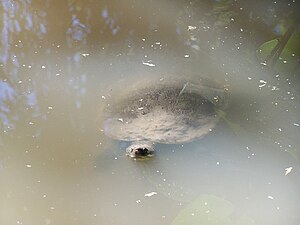Mary River Turtle
| Mary River Turtle | ||||||||||||
|---|---|---|---|---|---|---|---|---|---|---|---|---|

Mary River Turtle ( Australia Zoo ) |
||||||||||||
| Systematics | ||||||||||||
|
||||||||||||
| Scientific name of the genus | ||||||||||||
| Elusor | ||||||||||||
| Cann & Legler , 1994 | ||||||||||||
| Scientific name of the species | ||||||||||||
| Elusor macrurus | ||||||||||||
| Cann & Legler, 1994 |
The Mary River Turtle ( Elusor macrurus ) is a short-necked snake -necked turtle that lives in the Mary River , Australia . It has bimodal breathing , which means that it is also able to breathe through the cloaca . However, since it cannot take in sufficient oxygen through the anus, its head has to come to the surface regularly, but it can remain underwater for up to three days.
Elusor is a monotypic genus belonging to a very ancient branch of the turtle . The other species of this genus disappeared in the course of the evolutionary history of Australia.
features
The Mary River turtle is one of the largest species of tortoise in Australia. The largest animals reach a shell length of 42 cm. Newly hatched turtles have a shell length of 2-3 cm up to 5 cm. Adult Mary River turtles have an elongated, slender back shell that can be plain, colored, or patterned. The hues range from rusty red to reddish brown and almost black. The belly armor is colored from cream to pale pink. The skin color is similar to the shell and has a salmon pink color on the tail and limbs. The irises of the eyes are light blue in most cases.
A unique feature of the male Mary River turtles is the tail, as it can measure almost two-thirds of the total shell length and is flattened on the sides. The males use the tail like a rudder and as a drive like sharks. No other species of turtle has developed this type of locomotion during its evolution . The extraordinarily long beard threads under the lower jaw are also special features. The Mary River turtle has one of the smallest heads among turtles, but it has the largest hind feet of all species in the catchment area and is relatively fast thanks to those giant feet.
Because of the long time spent under water, there is sometimes a growth of algae on the shell or head of the turtle, a green " mohawk " characteristic of the Mary River turtle . Because of this, she was a popular pet in Australia in the 1960s and 70s . During this period about 150,000 specimens were separated from their habitat in order to live in the terrarium. They were therefore known as the Penny Turtle or the Pet Shop Turtle . The species is now acutely threatened with extinction.
Hazard and protection
The IUCN lists the Mary River turtle on the Red List as Endangered. The Zoological Society of London also lists them in their EDGE of Existence (Evolutionarily Distinct and Globally Endangered) program at number 29 on the list of endangered reptile species and justifies this with the destruction of their habitat and the fact that this turtle is at least 25 years old is sexually mature. The Australian Ministry of the Environment blames the intensive domestic animal husbandry of the 1960s and 1970s for the threat to the species.
Australia's first reptile-oriented , nonprofit conservation organization, the Australian Freshwater and Turtle Conservation Research Association , was able to breed this species in captivity in 2007.
literature
- Lee K. Curtis: Queensland's Threatened Animals . Csiro Publishing, 2012, ISBN 978-0-643-09614-1 , pp. 201-202
- Natalie J. Clark, Matthew A. Gordos, Craig E. Franklin: Thermal Plasticity of Diving Behavior, Aquatic Respiration, and Locomotor Performance in the Mary River Turtle Elusor macrurus . Physiological and Biochemical Zoology: Ecological and Evolutionary Approaches, Volume 81, No. 3 (May / June 2008), pp. 301-309 ( JSTOR )
- J. Cann, JM Legler: The Mary River Tortoise: A New Genus and Species of Short-necked Chelid from Queensland, Australia (Testudines: Pleurodira) . Chelonian Conservation and Biology, Vol. 1, No. 2, 1994, pp. 81-96 ( online copy )
Web links
- Elusor macrurus in The Reptile Database
- Mary River Turtle on Tiaro Landcare Group websites, accessed June 23, 2014.
- Mary River Turtle at Arkive, accessed June 23, 2014.
- MEET THE ULTRA PUNK-ROCK MARY RIVER TURTLE THAT'S BATTLING EXTINCTION on featurecrreature.com (lots of photos)
- Colin Packham: Australia's 'punk turtle' risks being last of the Mohicans . Reuters, April 13, 2018
- Sarah Gibbens: Turtle With Green Mohawk Faces Extinction . National Geographic, April 13, 2018 (images and video)
Individual evidence
- ↑ Lee K. Curtis: Queensland's Threatened Animals . Csiro Publishing, 2012, ISBN 978-0-643-09614-1 , pp. 201-202
- Jump up ↑ Species Profile and Threats Database, Australian Government, Department of the Environment: Elusor macrurus - Mary River Turtle, Mary River Tortoise , Canberra 2013, accessed June 23, 2014.
- ↑ Concern for the Iroquois turtle. Spiegel Online, April 12, 2018, accessed April 16, 2018 .
- ↑ Elusor macrurus (Mary River Turtle). Retrieved April 12, 2018 .
- ↑ Punk Tortoise and Giant Salamander. Wiener Zeitung GmbH, April 13, 2018, accessed on April 16, 2018 .
- ↑ TOP 100 EDGE Reptiles. Zoological Society of London, accessed April 16, 2018 .